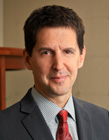Raising the Bar: Courting Public Opinion
 by W. Blair Meeks
by W. Blair Meeks
Communication Strategist
Jackson Spalding
If you’re a student of crisis communications, there has been no shortage of monumental, real life case studies recently. Herman Cain troubles have drifted into Jerry Sandusky shock waves and the 24-hour news cycle keeps churning up headlines. A sidebar discussion worth having, however, relates to the legal ramifications and legal wisdom of all this public disclosure. When you represent a client whose reputation could soon be taking a severe public beating, what is the tipping point that triggers your entry into the court of public opinion? Helping to define that tipping point is how we will be Raising the Bar this month.
Herman Cain, of course, is running for President. There was no decision about whether he should speak publicly once charges of sexual harassment surfaced. He’s a public figure running for the highest office in the land. He had to say something. How he handled what he said is open for debate, but there is no disputing that he had to react publicly. Since legal wrangling related to the events in question are long past, there was no immediate legal weight tipping the scales of his response decision.
The Sandusky case is much different. Sandusky is the former Penn State assistant football coach whose legal fate on child-sex abuse charges is still very much in doubt. His phone interview with NBC’s Bob Costas for a national broadcast, along with the on-camera interview with his attorney, took place long before even the preliminary hearing in his case.
So how do you decide whether or when to speak to the media? The State Bar of Georgia has rules on trial publicity. Rule 3.6 warns lawyers not to communicate publicly about a case when they know it’s likely to impact a judicial result. Of course, that’s softened with follow-up language that allows publicity that protects a client from the influence of other negative publicity about the case. It’s helpful to note the maximum penalty for violating this rule is a public reprimand, and according to Ed Bean, editor in chief of the Fulton County Daily Report, the State Bar has never issued a single citation for violating this rule in Georgia.
Beyond rules, however, it’s a question of client service. Many times, if you fail to act in the court of public opinion, permanent damage is done to the client before legal proceedings can even get started. Even if you win the case, in some situations there is no recovering for the client.
Here are a few questions to help determine that tipping point:
• How much and how pervasive is the negative attention? No doubt the Sandusky case is huge, but smaller cases make for tougher decisions. Have local TV stations and newspapers covered the story? How widespread is knowledge of the case and the client? Will you be causing more coverage and attention by speaking out?
• What can you say? There may be challenges to telling the whole story – protecting witnesses, doctor-patient privileges. Legal guidelines prevent discussion of some aspects of certain cases. Will you be so handcuffed by rules or ethical considerations that you can’t influence the public debate?
• Who will say it? The strength of your spokesperson is critical. People want to hear from the accused, but that may not be the best option. Who has experience? Who knows the case the best? Who will have the most impact without furthering damage?
• What good will it do? Are there future business or relationship interests that can be protected through speaking publicly?
• What damage may be caused? Can speaking publicly damage the legal case? Can it subject the client to further embarrassment or reputation damage?
• What manner of delivery is best? An on-camera interview sends a strong visual message, but a written statement provides much more control.
Sandusky’s case is extreme, but it does provide a good example. His national phone interview was bold, but his message was weak. It did attach a human voice to the person charged with these terrible crimes, but it was not a strong denial. He sounded pitiful, not offended and the move probably didn’t win many supporters. Sandusky’s attorney sounded more convinced of his client’s innocence than Sandusky himself.
Rules are flexible in the court of public opinion, which means managing the scale to define your tipping point to enter must be a carefully considered process.



